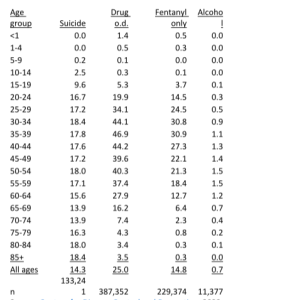American journalists, politicians, and interest groups left to right agree: It’s okay to lie about teens.
Mike Males | February 2023
Ninety-nine percent of the tens of thousands of news stories and commentaries on teenagers, suicide, and drug overdose lie. The willfully create a false impression.
UCLA Health is cruder than most, posting the flat lie that “suicide rates (are) highest among teens and young adults.” Other commentators are more subtle, dodging the disappointing truth about “rates” and instead reciting the scary-sounding but grossly misleading: “suicide is the third leading cause of death among teens.”
That’s meaningless. Of course an external cause like suicide, along with accidents and homicide, would be leading death categories for teens, since teens rarely die from major natural causes like heart disease or cancer.
It’s understandable that press reporters and the late comedian George Carlin might confuse “high rate” with “leading cause.” But it is astonishing that UCLA’s famed Child and Adolescent Psychiatry unit would be so ignorant and indifferent regarding basic suicide facts that such a mistake could remain posted.
In the 1980s, authorities caught psychiatric hospitals grossly sensationalizing suicide to scare parents into filling overbuilt hospitals with teenage patients. Of course, UCLA Health took down my complaint within hours – but left their false posting up. That’s typical of American attitudes. Lying about teens is ok; correcting lies is forbidden.
Look for yourself. Every article on “teen suicide” and most on drug abuse (especially fentanyl) contain the meaningless “leading cause” claim but universally omit the much more relevant, contextual fact that teenage rates of suicide and overdose are much lower than adults’ rates.
Table 1 details the important and most recent statistics no one else will present. It combines high-schoolers with higher-risk 18-19 year-olds and includes only immediate, not chronic, deaths.
Even with these conservatisms, adults of ages to be parents to teenagers are twice as likely as teenagers to commit suicide, 7.5 times more likely to fatally overdose on drugs, including 6 times more likely for fentanyl, and 15 times more likely to fatally binge-drink. Teens comprise 13.4% of the teen-adult population but account for only 5.6% of suicides, 1.5% of drug overdoses, 1.8% of fentanyl deaths, and 1.1% of binge-drinking deaths.
Not only do commentators omit these crucial realities omitted from discussion, they peddle exactly the opposite impression that teens are riskier than adults. This blatant misrepresentation contains more cruelty than concern. Teenagers who suffer at-risk parents are afforded no attention, sympathy or official help. No one advises teens on administering Narcan to parents who overdose on fentanyl – a family crisis eight times more likely than a high-schooler overdosing.
Major interests evade high adult rates of suicide and overdose, especially among White middle-aged men, because mental disturbances and addiction are deeply stigmatized in American culture, especially by medical and psychological authorities. The American prejudice is to pretend suicide and drugs afflict only powerless groups, like youth.
These unreasoning bigotries hamper reasoned solutions to America’s social crises, evident in staggering suicide and overdose tolls. We should learn why supposedly “impulsive” teens have such low rates of suicide, not inventing bogus measures to scapegoat them.
Table 1. Deaths from suicides and suicide-suspected deaths, drug and fentanyl overdose, and alcohol overdose, average annual rates per 100,000 population by age group, 2020-2022 (provisional).

Source: Centers for Disease Control and Prevention, 2023.
